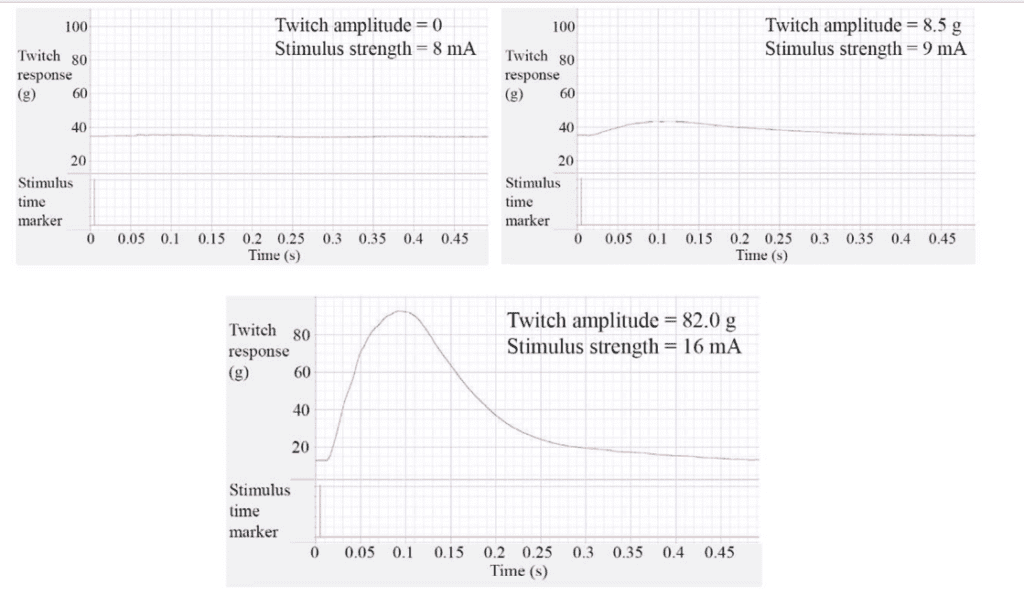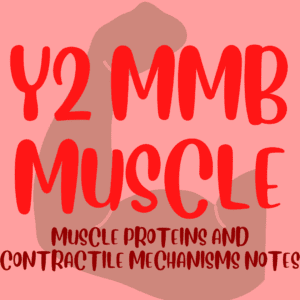 OCaPE: MMB #4
OCaPE: MMB #4
MMB Muscle EMG Lab
Author: Joel Mitchell


10 minutes | 40 marks
Q1)
Why is the abductor minimi muscle not stimulated directly?
Direct electrical stimulation of muscle causes recruitment of large motor units first
as it is the path of least resistance.
However, nervous muscle twitch recruitment follows the Henneman Size Principle that small motor units are recruited before large motor units. (5)
Why is there no muscle twitch at 8mA?
stimulus strength is below threshold
to generate end plate potential large enough
for activation of small muscle units (3)
What happens at a stimulus strength of 16mA?
Maximal muscle twitch amplitude as stimulus is above threshold
small muscle units are recruited and then larger muscle units are recruited (3)
The twitch amplitude does not increase after 16mA. Explain why this is the case/
There is no further increase in the twitch response
with increase in stimulus strength above maximal stimulus
All motor units have been maximally recruited. (5)
In the next experiment, multiple stimuli are delivered in quick succession, please take a look at their experimental data.

Why has the amplitude increased?
Two successive stimuli delivered before the recovery period
causes temporal summation due to rate coding
in which a high frequency of action potentials in the presynaptic ulnar nerve
elicits summating postynaptic compound muscle action potentials (3)
What do these two graphs show?

Left – incomplete tetanus
Right – complete tetanus
This is a sustained contraction in response to repeated stimulation with a frequency which does not allow the muscle to relax (3)
In this final experiment, the muscle stretch reflex was investigated. Please take a look at this last set of data.

Label the two lines obtained.
Explain the initial response from stimulus intensity of 1-3.
Only H-reflex: muscle spindle bypassed, activation of 1a afferents to single spinal cord synapse with alpha-motoneurone, Orthodromic.
No M-response: no direct stimulation of the alpha-motoneurone as stimulus not high enough to activate larger, higher threshold motor neurones (compared to 1a afferents). (5)
Why does the H-reflex amplitude start to fall as the M-response amplitude increases?
As stimulus intensity increases, the stimulus is large enough to activate larger, higher threshold alpha-motoneurone (M-response) as well as the H-reflex.
The M-response results in both orthodromic transmission to the effector soleus muscle and antidromic transmission back to the spinal cord blocking stimulation by the H-reflex by antidromic collision. (5)
Explain why the latency of the H-reflex is likely to be different from that of the ankle jerk reflex.
H-reflex latency should be lower due to shorter distance travelled.
H-reflex (point of stimulation of the tibial nerve in the posterior fossa, to the spinal cord motor neuron and then to the soleus muscle)
Ankle Jerk ( spindles to the spinal cord and back to the muscle
SO THERE IS A SHORTER DISTANCE TRAVELLED IN THE H REFLEX(5)
Key Concepts for this station:
Similar resources:
- All
- CPSA
- Lecture Notes

Y2 OCaPE: MMB5 Muscle Physiology

All Upper Limb Pathologies on one page! | MMB

Y2 Notes: MMB Notes on Normal and Abnormal Bone Growth

Y2 Notes: MMB Notes on Bone and Soft Tissue Tumours

Y2 Notes: MMB Notes on The Red Hot Joint

Y2 Notes: MMB Notes on Investigation of Muscle Action

Y2 Notes: MMB Notes on Muscle Function in Health and Disease

Y2 Notes: MMB Notes on The Neuromuscular Junction

Y2 Notes: MMB Notes on Connective Tissue Fibrous Proteins

Y2 Notes: MMB Notes on Muscle Proteins and Contractile Mechanisms

Y2 Notes: MMB Notes on Reflexes

Y2 Notes: MMB Notes on Muscle and Movement

Y2 Notes: MMB Notes on Control of Fuel Selection in Muscles

Y2 Notes: MMB Notes on Infections of Bones, Joints and Muscles

Y2 Notes: MMB Notes on Limb Development

Y2 Notes: MMB Notes on Histology of Skeletal Muscle

Y2 Notes: MMB Notes on Cartilage

 (3)
(3)